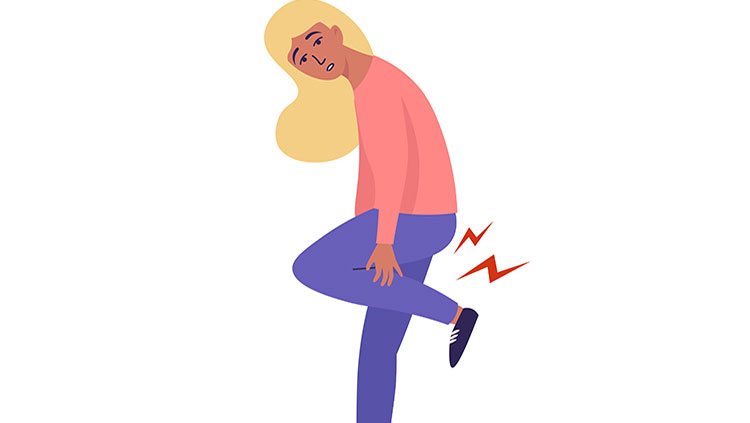What Causes Muscle Cramps?
- Published2 Jul 2020
- Author Michael W. Richardson
- Source BrainFacts/SfN

It’s the middle of the night. Maybe you’re enjoying a pleasant dream or getting some well-needed rest. Then, suddenly, your leg feels like it’s on fire. You shoot up in bed. It’s that scourge of sleep — a charley horse, a common term for a leg cramp. In the moment, the pain is so intense it feels like everything from your knee down could fall off. But if you manage to go back to sleep, your leg will probably feel as good as new in the morning.
It was just a muscle cramp, caused by the involuntary contraction of muscle groups. Muscles are linked to the brain via nerve fibers and can send pain signals to indicate something has gone wrong. Contractions are painful, but most cramps don’t lead to any long-term damage or side effects. Still, it’s unpleasant and a little scary when a part of your body is rendered useless until the pain subsides. And some people suffer nighttime cramps so frequently that it often interferes with their sleep.
Cramping can affect anyone, from trained athletes to couch potatoes. But how and why do those involuntary contractions happen? Can we prevent cramps before they strike? We asked Bruce Palmer Bean, professor of neurobiology at Harvard Medical School, all about cramps.
First off, what is a muscle cramp? And how is the brain involved?
A cramp is an involuntary, sustained contraction of muscle fibers. If you’re, say, curling your bicep, you perform that action by contracting and shortening the muscle fibers in your arm. Muscle movements are controlled by motor neurons, which connect the brain’s movement centers to the muscles via the spinal cord.
During a cramp, the muscles tighten without voluntary input from the brain, and they tighten too much. At this point, pain receptors near the muscles signal the brain that something is wrong. Cramps most often occur in muscles that we use a lot, like your arms and fingers. But leg cramps are the most common.
What causes cramps?
Actually, we don’t really know. The last 20 years of study have offered several hypotheses, but modern research debunked many of them.
For example, one of the most common explanations was that dehydration caused cramps. This was considered conventional wisdom — many athletic trainers still suggest drinking more water to prevent or fix cramps. But modern research shows hydration has very little to do with exercise-induced cramps. Athletes at very high levels who carefully monitor the amount of liquids they consume still suffer from cramps. The myth can be harmful — people who try treating cramps by drinking more water can overdrink and even suffer from water poisoning.
Another folk remedy for cramps is eating bananas. The idea is that potassium helps get rid of cramps. But there is no evidence for this. Some diseases, like kidney disease or persistent diarrhea, can cause potassium to drop to critical levels, and those conditions can result in cramping. It is highly unlikely that even intense exercise can cause changes in potassium levels sufficient to cause cramping. The amount of potassium in the bloodstream is tightly regulated by the body. Eating a banana wouldn’t cause a surge of potassium to the site of a cramp. If your cramps go away after eating a banana, it’s likely a coincidence, or even the placebo effect in action.
Nowadays, most researchers believe the source of cramps is hyperactivity of motor neurons, rather than muscles. Motor neurons located in the spinal cord give the signals for muscle contraction. For some reason, when a neuron-muscle pair is used repeatedly during prolonged or vigorous exercise, the neuron can start to fire uncontrollably. This might be the cause of involuntary contractions.
If this is the case, cramps are like epileptic seizures — also caused by neurons firing when they shouldn’t. Unfortunately, it also suggests there’s no known prevention method or cure for muscle cramps, other than giving your muscles — and your motor neurons — a break.
Why do people get cramps while they’re sleeping, like a charley horse?
Calf cramps are common because your calves work hard all day — every time you’re on your feet or walking, those motor neurons are firing. And if you engage in an activity that’s not part of your daily routine, like riding a bike for the first time in a while, cramping is more likely that night because those neurons have been firing much more than in your day-to-day life.
At night, the brain changes the amount of neurotransmitters it releases. These neurotransmitters, like serotonin and dopamine, regulate the transmission of signals between neurons, and help modulate all brain activity, including activity in the spinal cord and in motor neurons. It’s possible this change in neurotransmitters makes misfiring more likely, which would explain why charley horses are common while sleeping. But we don’t know enough to say that is the definitive cause.
Why are cramps so hard to study?
Our lab works with mice, but there are no experimental models in mice or other lab animals that we can use to study cramps. Other animals seem to experience cramps, like racehorses, but the causes have not been studied in a lab setting. Since we can’t observe neuron activity during a cramp, most of what we know is a matter of conjecture.
Also, the spinal cord is a very complicated structure, involving dozens of different types of neurons interacting with one another. We still have a lot to learn about these different neurons and their interactions and how all their actions are controlled. So, this very common human experience remains very mysterious.
BrainFacts.org welcomes all your brain-related questions.
Every month, we choose one reader question and get an answer from a top neuroscientist. Always been curious about something?
Please submit your question by filling out this form.







